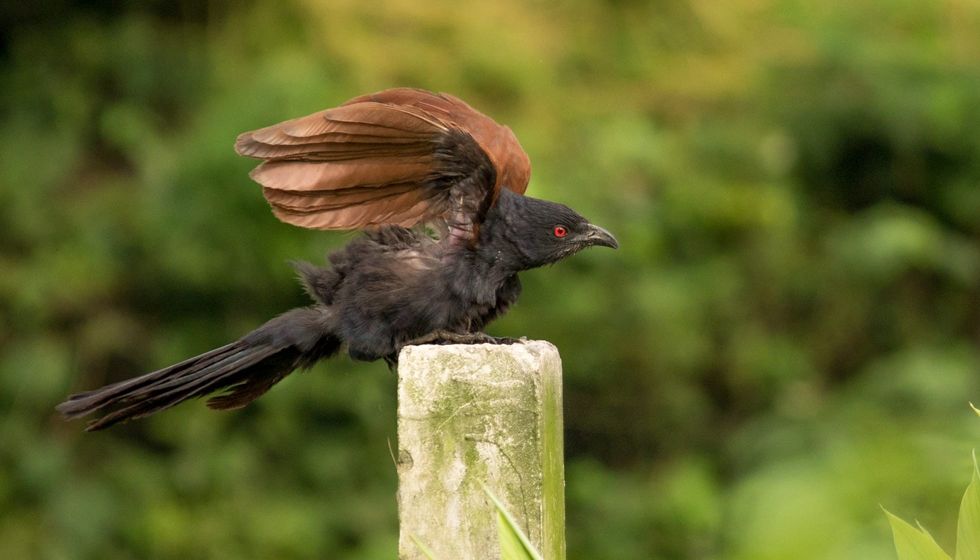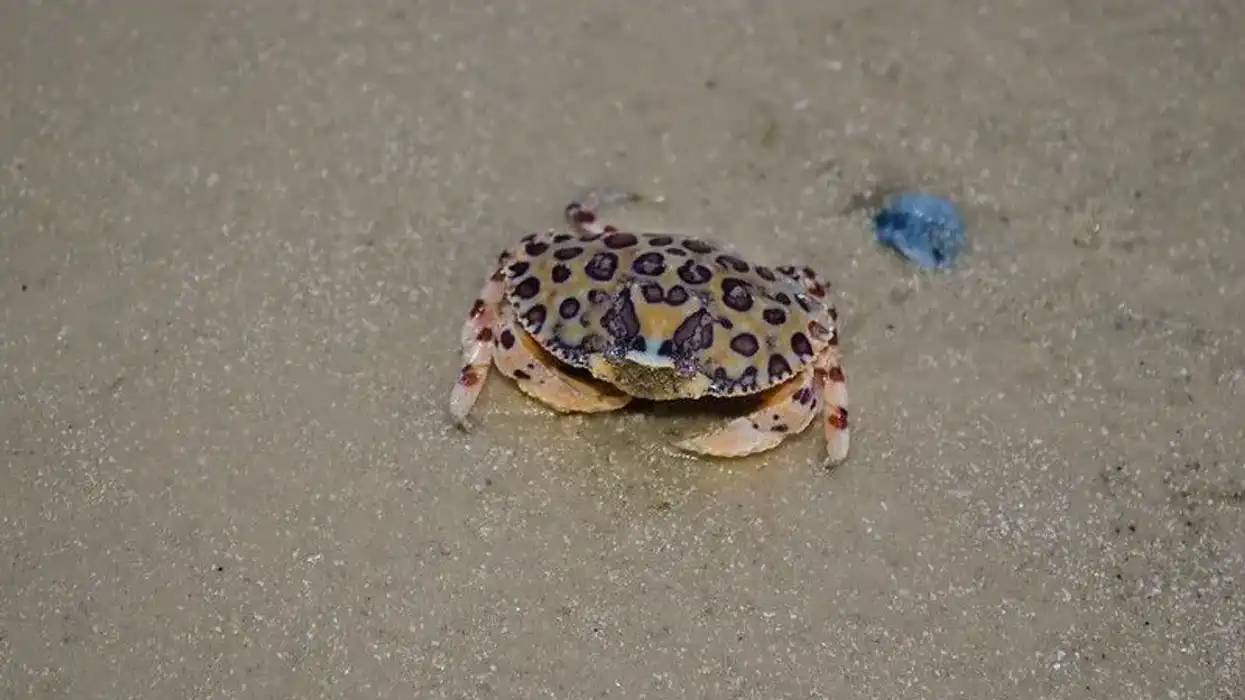The lesser coucal (Centropus bengalensis) is a kind of cuckoo with some interesting characteristics. It is found in the open country and marshlands of India, Nepal, Thailand, Indonesia, Cambodia, Bhutan, Bangladesh, and Singapore, among others.
This species of bird has several subspecies, of which the ones found in the islands of Indonesia and China are larger than the Centropus bengalensis. The greater coucal, of the same genus Centropus, is considered to be very similar to the lesser coucal, and which may cause problems with their identification in the wild.
They have been categorized as Least Concern by the IUCN Red List because of their large population and widespread distribution among the international birdlife.
Although most cuckoos are known to be brood parasites, most coucals, including the lesser coucal, tend to their eggs themselves. The male birds care more for the young than the female birds.
If you want to read about more birds, check out our European robin facts and Rufous-backed robin facts pages.
Lesser Coucal Interesting Facts
What type of animal is lesser coucal?
The lesser coucal (Centropus bengalensis) is a type of bird.
What class of animal does lesser coucal belong to?
The lesser coucal (Centropus bengalensis) belongs to the class Aves, order Cuculiformes, family Cuculidae and genus Centropus.
How many lesser coucals are there in the world?
The exact number of these birds in the world is currently unknown but according to the IUCN, their population is increasing in their range, which is also why they have been classified as Least Concern.
Where does a lesser coucal live?
Species and subspecies of the lesser coucal (Centropus bengalensis) are mainly found among the birdlife of the marshy lands of the Indian subcontinent and the Southeast Asian countries of Thailand, Indonesia, Cambodia, Laos, Vietnam, as well as China and Taiwan.
What is a lesser coucal's habitat?
These birds prefer habitats that consist of open country, moist shrublands, marshlands, mangroves, swamps, and peatlands, where plenty of grass and vegetation is available. Their population is not usually found among the birdlife in forests or in areas below 4900 ft (1500 m) above sea level.
Who do lesser coucals live with?
The lesser coucal (Centropus bengalensis) is known to live either alone or in pairs as these birds are monogamous, which means that they mate for life. After raising their young, the parents separate from the juveniles, who then go on to find their own territories and stay within that range.
How long does a lesser coucal live?
There is not enough data regarding the lifespan of this species of birds. However, its generation length is 3.8 years, which is the average number of years between two consequent generations of a species.
How do they reproduce?
The breeding season for the lesser coucal (Centropus bengalensis) starts in May and lasts till September. Their nests are made in the shape of a dome made from blades of grass and twigs and are located in low trees and shrubs.
They lay two to four eggs in a clutch, depending on which part of their geographic range they are in.
Both the males and females of this species do their part in caring for the young, as well as incubating the eggs. The male bird is said to care for the hatchlings more than the female bird as in the genus Centropus, gender roles are reversed.
What is their conservation status?
The population trend of the lesser coucal (Centropus bengalensis) within their distribution and range has been assessed to be increasing and thus, they have been classified as Least Concern by the IUCN Red List.
Lesser Coucal Fun Facts
What do lesser coucals look like?
The lesser coucal (Centropus bengalensis) has two kinds of plumages: breeding and non-breeding. In the breeding plumage, the head is dark and the wing feathers are mostly reddish-brown or rufous and have dark shafts on their feathers.
In the non-breeding plumage, there are white feather shafts on the head and wings, which are also colored a dull rufous. The tail in this species of birds is long and the central tail coverts are long with some barring.
The beak of the lesser coucal is small, curved, and a pale yellow in color. The juveniles are browner in color with black spots and bars. The lesser coucal sound is a very sharp one.
They are highly threatened by the international pet trade. Bengalensis gmelin is a similar Critically Endangered bird.
How cute are they?
A bird of this species might look a little intimidating at first but their sleek and beautiful plumage is sure to win you over in no time. Thus, they can be considered quite cute.
How do they communicate?
The birds call of the lesser coucal (Centropus bengalensis) consists of sharp notes that sound like 'whoot whoot'. Some say that their bird call sounds very similar to a bouncing ball. They might use this call to establish their territory like most other birdlife.
How big is a lesser coucal?
The lesser coucal (Centropus bengalensis) measures 11.8-15.7 in (30-40 cm) in length, although some subspecies of this bird found in Indonesia are suspected to be even bigger in size. This species is almost three times smaller than the Indian peafowl, which is also a common bird found within the birdlife in India.
How fast can a lesser coucal fly?
There is not enough data available concerning the speed with which the lesser coucal (Centropus bengalensis) flies but the bird is known to be a ground-dwelling species and is a weak flier. Unlike most other birds of the world, the lesser coucal (Centropus bengalensis) prefers to stay on the ground within its habitat to forage.
How much does a lesser coucal weigh?
The average weight of the lesser coucal (Centropus bengalensis) can range from 3-5 oz (90-150 g). Another colorful bird that weighs about the same is Meyer's parrot.
What are the male and female names of the species?
There are no specific names for the male and female lesser coucal (Centropus bengalensis).
What would you call a baby lesser coucal?
A baby lesser coucal (Centropus bengalensis) may be called a chick or a hatchling. However, before it matures into an adult bird, it is called a juvenile.
What do they eat?
The diet of the lesser coucal (Centropus bengalensis) consists of insects such as caterpillars, lizards, grasshoppers, spiders, cicadas, and crickets, which they find on the branches and leaves while foraging or catch them in the air.
Are they dangerous?
The lesser coucal (Centropus bengalensis) is not considered to be particularly dangerous to human beings. In fact, they scurry deep into the vegetation whenever approached by humans in their habitat.
Would they make a good pet?
Considering their uneasiness around humans whenever bothered, it is unclear whether the lesser coucal (Centropus bengalensis) would make a good pet. However, their international pet trade might become a threat to their population in the world.
Did you know...
The hind claw of the lesser coucal, Centropus bengalensis, is so long that this species has the longest hind claw in its genus Centropus.
Different types of coucals
There are approximately 30 different species of coucals in the world and almost all of them are ground-dwelling birds, unlike so much of the international birdlife.
They are characterized by their strong hind claw and the reversal of gender roles in their species in the breeding process, wherein the male bird cares more for the young than the female bird.
They are found all around the world among the international birdlife, especially in Africa, South Asia, and Australia.
Some of them, like the pheasant coucal and the white-browed coucal, are among the most prominent predator birds of the world. Most coucals have been classified as Least Concern by the IUCN Red List.
Lesser coucal vs greater coucal
The lesser coucal (Centropus bengalensis) and the greater coucal (Centropus sinensis) greatly resemble each other in appearance and choice of habitat except for some differences. Greater coucals have a much more widespread distribution in the world and they have bright red iris, unlike the lesser coucal's dark brown ones.
The lesser coucal (Centropus bengalensis) is also much smaller in size than the greater coucal.
Here at Kidadl, we have carefully created lots of interesting family-friendly animal facts for everyone to discover! Learn more about some other birds from our cliff swallow fun facts or vermillion flycatcher fun facts pages.
You can even occupy yourself at home by coloring in one of our free printable lesser coucal coloring pages.









